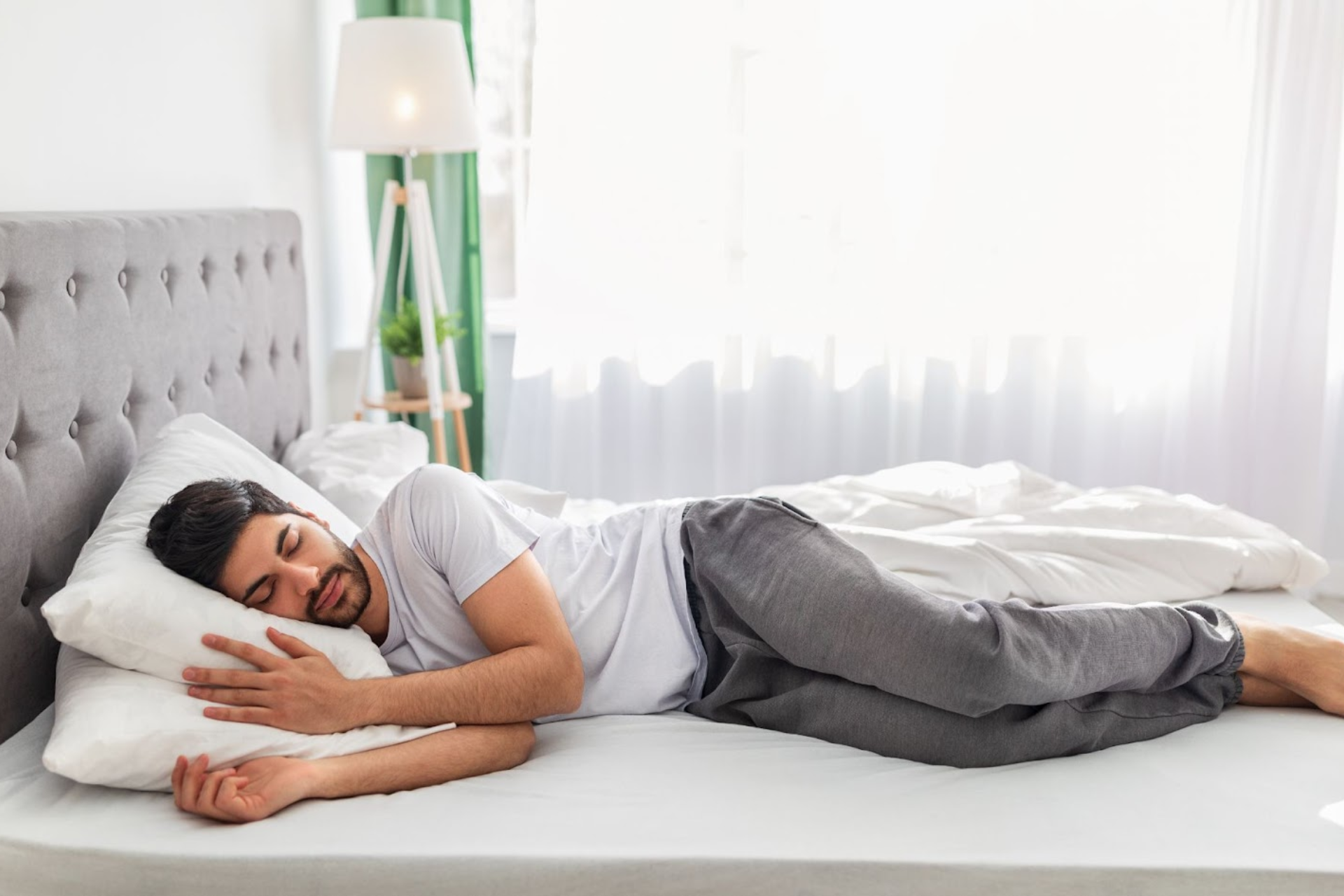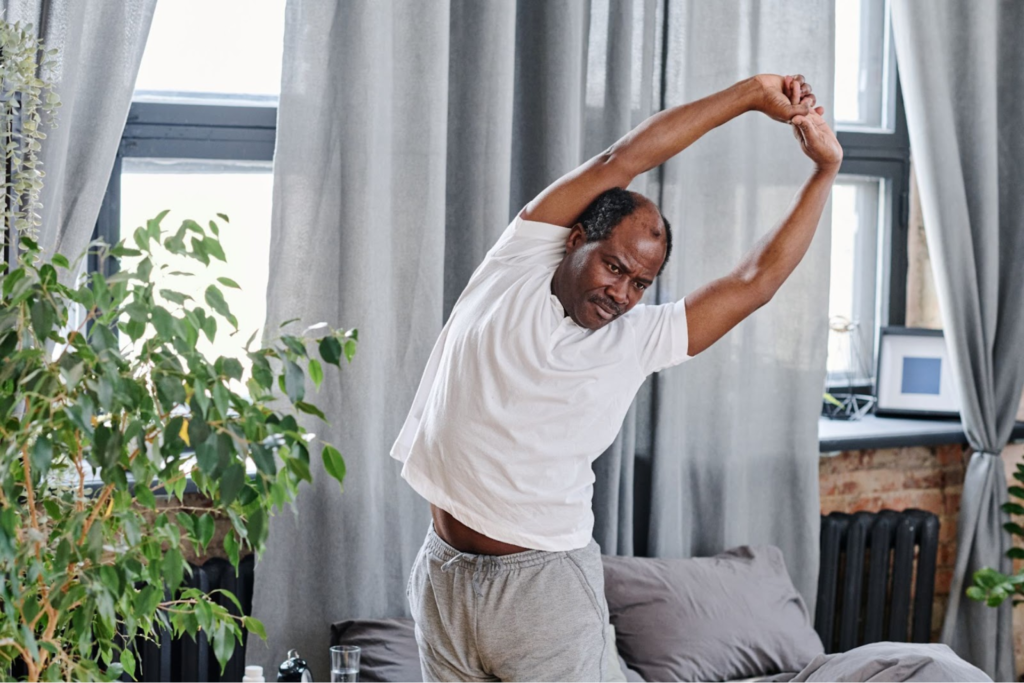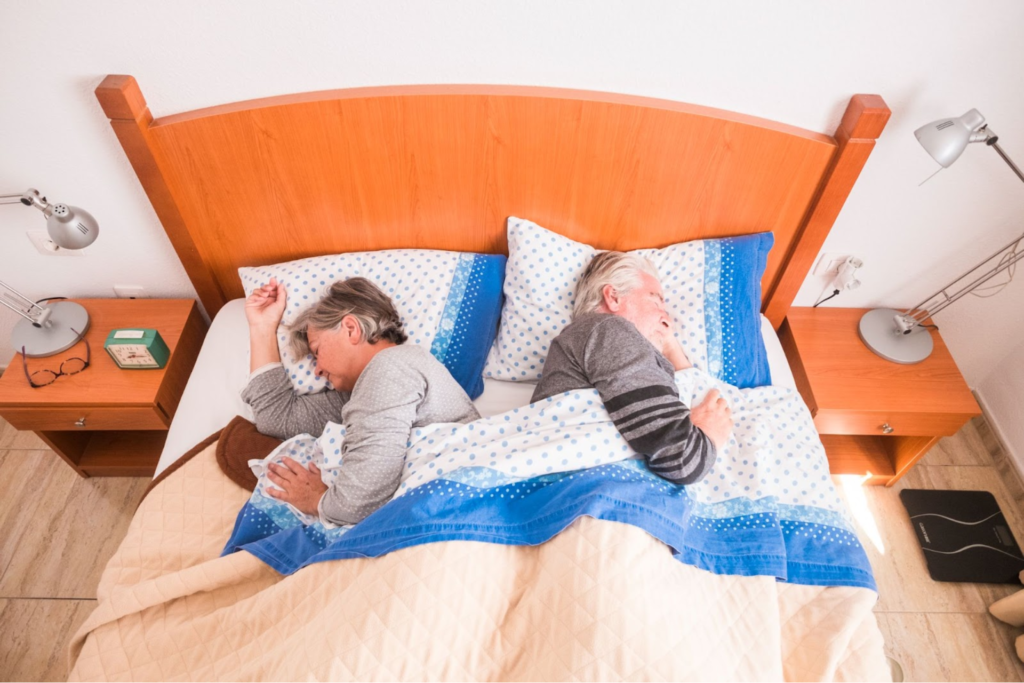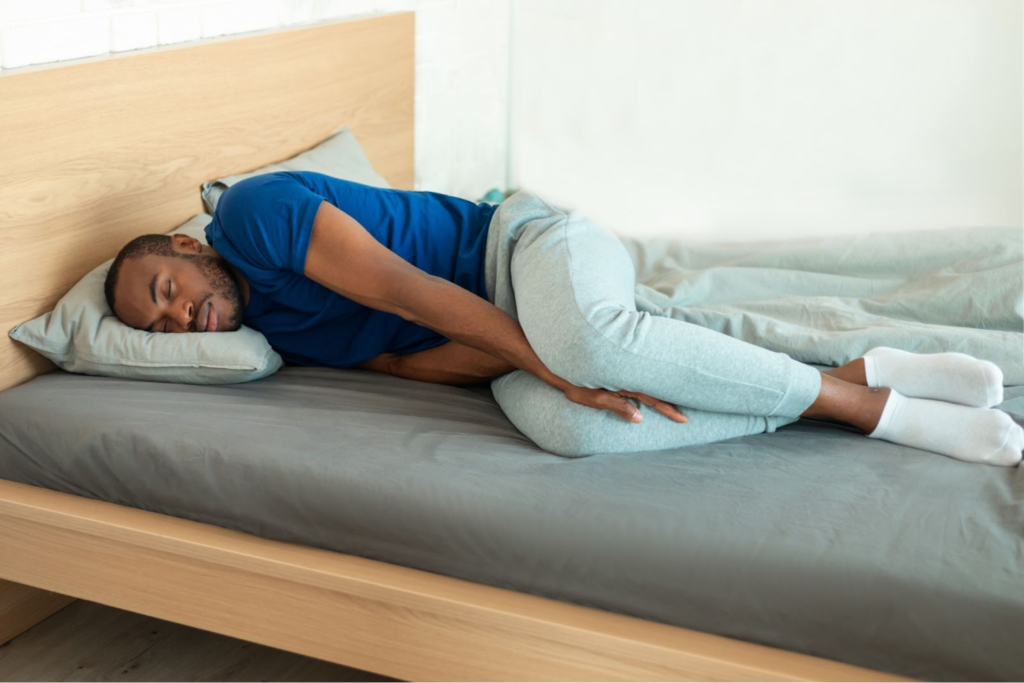What’s your preferred sleeping position? A while back, we wrote an article about the best sleeping position for great sleep, where we discussed popular sleeping positions across your back, stomach, and side.
But this time, we want to talk about one particular sleep position— your side.
60 percent of adults prefer sleeping on their side— which is great because it’s one of the healthiest sleep positions, according to sleep experts!
However, there are still a few things you need to know if you’re a side sleeper or want to be one.
The Benefits of Sleeping on Your Side
Aside from a good night’s sleep, you can get some excellent potential benefits from sleeping on your side. Some of them may even surprise you!
Some of these benefits include:
- Improved spine alignment
- Can help relieve back pain
- Reduced heartburn risk
- Reduced snoring risk
- Better digestion
- Better brain health
- A healthier pregnancy
Believe it or not, the side of your body you sleep on actually makes a difference when it comes to sleep health.
Left or Right: Which Side is Better?
When it comes to side sleeping on your side, there is no “best sleep position.” In fact, your unique health needs may be the defining factor of whether you should sleep on your left side or your right.
Here are a few examples.
Pregnancy
It’s crucial to get enough healthy sleep during pregnancy— unfortunately, for many moms-to-be, this is much easier said than done. This is because, even outside of a growing baby and the hormonal and bodily changes every pregnant woman goes through, other factors can make getting a good night’s sleep tricky. These include:
- Aches and pains
- Insomnia
- Difficulty getting comfortable in bed
- Restless Legs Syndrome
- Nocturia— getting up to use the bathroom during the night
- Heartburn, GERD or acid reflux
Many experts agree that sleeping on your left side is most beneficial during pregnancy. Sleeping on your left side allows maximum blood flow throughout your body and to your baby and placenta. It also improves kidney function, which makes it easier for your body to eliminate waste products and potentially reduces swelling in your hands, ankles, and feet. [1]
Gastroesophageal Reflux Disease (GERD)
If you suffer from GERD or acid reflux at night, sleeping on your side can help reduce your symptoms, which are typically more severe at night. Sleeping on your left side reduces instances of heartburn more effectively than sleeping on your back or even on your right side.
In fact, sleeping on your right side if you have GERD may actually make your symptoms worse!
One clinical trial found that heartburn episodes were more frequent when participants slept on their right side and lasted longer. [2]
Sleeping on your left side is also beneficial for pregnant women who experience nighttime GERD.
Heart Failure
If you have heart failure, it’s actually more beneficial to sleep on your right side. In fact, you should avoid sleeping on your left side if you have heart failure.
Sleeping on your left side normally improves how well your heart pumps blood throughout your body. However, with heart failure, sleeping on your left side can cause further discomfort due to the damage in your heart.
These are just a few examples, but sleeping on your side has plenty of potential benefits. However, it’s not necessarily the “perfect” sleep position.
Potential Downsides to Sleeping on Your Side
For some, the cons of side sleeping may outweigh the pros. In particular, two drawbacks to sleeping on your side are back and shoulder pain and the potential for more wrinkles.
When you sleep on a single side, one side of your face is pressed into your pillow for an extended length of time. This compresses or stresses your skin, which can cause wrinkles.
Sleeping on the same side for a long time can put extra pressure on the shoulder you sleep on, as well as your hips and lower back. This can cause or worsen shoulder, hip, or lower back pain. Sleeping on your side can also potentially cause lower back pain if your spine isn’t properly aligned.
However, there is an easy way to prevent these potential issues. If you can, simply alternate which side you sleep on each night to help prevent any aches, pains, or wrinkles. If you spend one night sleeping on your left side, spend the next on your right, et cetera.
However, if you find yourself sleeping on your side more than any other sleep position, that can actually be a sign of a serious, underlying issue.
Sleep-Disordered Breathing and Sleeping on Your Side
It’s not uncommon for people with sleep-disordered breathing to sleep more on their side than in any other sleep position. In fact, this is a subtle but telling sign that you may not be getting the good night’s sleep you need.
Sleep-disordered breathing can refer to multiple conditions that cause abnormal breathing patterns while you’re asleep. Sleeping on your side is more than just a comfortable way to sleep— it’s also an important survival mechanism your body uses while you rest. Sleeping on your side helps keep your airway open while you sleep and prevents obstructions from interrupting your sleep.
So if you’re struggling with sleep-disordered breathing, this could be the difference between healthy rest and poor sleep. This is why it’s recommended that people with obstructive sleep apnea (OSA) sleep on their side rather than on their back or stomach.
If you’re one of the millions of Americans suffering from obstructive sleep apnea, sleeping on your side could be your body’s way of reacting to reduced airflow and restricted breathing at night. Because you experience symptoms of sleep-disordered breathing while you are sleeping, it can be difficult to tell that anything is amiss until you’re already feeling those effects.
Some signs of sleep-disordered breathing you should be aware of include:
- Loud snoring
- Pauses in breathing during the night
- Gasping for air, coughing, or choking during sleep
- Dry mouth
- Morning headaches
- Fatigue or brain fog during the day
It’s not always easy to sleep in a new position if you’ve been a lifelong back or stomach sleeper. Thankfully, getting yourself used to sleeping on your side is quite simple. It’s so simple, in fact, that you may kick yourself for not trying it earlier!
Four Easy Tips for Better Sleep on Your Side
You don’t have to keep waking up on the wrong side of the bed each morning. Your sleep position can help you wake up refreshed and ready to take on the day— or it can contribute to that dreaded sluggishness that puts a damper on your whole day.
Don’t worry— here are our five easy tips to help you sleep on your side and get the good night’s sleep you deserve.
1. Sleep on the Right Mattress
Your mattress can make or break your ability to get the healthy sleep you need each night. When it comes to sleeping on your side, not all mattresses are created equal.
The best kind of mattress for side sleepers is one that supports the entire body, and cushions the parts of the body that may press deeper into the mattress— like your shoulders and your hips.
Of course, you want your mattress to be comfortable as well. A supportive mattress won’t help you sleep better if you don’t enjoy sleeping on it.
If you’re one of the millions of Americans who have obstructive sleep apnea (OSA), the right mattress can make getting a good night’s sleep easier. Sleeping on your side helps keep your airways more open, helping you breathe easier while you sleep.
2. Use the Right Pillow
Like your mattress, your pillow can be the difference between refreshing rest and another rough morning. The right pillow helps support the correct alignment between your neck and your spine and provides pressure relief throughout your body. In fact, if you wake up with neck pain, your pillow is likely the culprit.
Ideally, your pillow should fill the space between your neck and the edge of your shoulder. A thin pillow— like an old, worn-out feather pillow— may be providing inadequate comfort and support. A thicker pillow like a memory foam or latex pillow can help provide the comfort and support you need to rest and wake up comfortably.
If you have sleep apnea, the right pillow supports your neck and helps your airways stay open throughout the night.
For excellent neck support and comfort, we recommend the lineup of pillows from Luma Sleep.
3. Sleep in the Fetal Position? Do It Right
Many Americans prefer sleeping in the fetal position— in fact, 54 percent of women and 39 percent of men prefer this position above the others.
Sleeping in the fetal position can be a good option if you’re trying to sleep on your side. However, it’s important to sleep in this position right to really enjoy that comfort. Curling up too tightly can restrict your breathing and cause aches and pains, making getting up in the morning a chore. This can be especially troublesome if you have sleep apnea.
4. Train Yourself to Sleep on Your Side
For some, the hardest part about sleeping on your side is getting used to it, especially if it’s not your preferred sleep position. But training yourself to sleep on your side is actually pretty easy— and you can do it with objects you already have at home.
- Use extra pillows. Placing pillows around your body can help prop you on your side while you sleep, even if you tend to roll over during the night. A body pillow can also help keep you comfortable on your side.
- Make it uncomfortable to sleep in other positions. It’s much easier to sleep on your side when you cannot sleep on your back or your stomach. One way to do this is to attach a small object— think a tennis ball or a bundle of socks— to the front and/or back of your shirt. When you try to roll over onto that side, that small object will make it uncomfortable or awkward to stay in that position. This will prompt you to roll onto your side and sleep in that position.
Remember, sleeping on your side is recommended if you have sleep apnea since it can make it easier for you to breathe better and sleep better at night.
Is Poor Sleep a Thorn in Your Side?
There’s no such thing as a “best” sleeping position, but sleeping on your side can help relieve or prevent discomfort during the night. However, if sleeping on your side isn’t helping you get the good night’s sleep you need, then that’s likely a sign of another problem.
If you’re experiencing signs of sleep-disordered breathing, waking up tired even after a full night’s sleep, or taking 30 minutes or more to fall asleep, then it’s important to talk to your doctor or a sleep expert. They may recommend a sleep study to see what the culprit is.
When it comes to healthy sleep, you should always err on the side of caution. If you’re not getting the refreshing sleep you need to function, contact us at the Sleep Centers of Middle Tennessee today to schedule a consultation. We can help back sleepers, side sleepers, and stomach sleepers alike get the great sleep they need every night.
References
- de Bellefonds, Colleen. “Sleeping Positions during Pregnancy.” What to Expect, WhattoExpect, 25 May 2022, www.whattoexpect.com/pregnancy/sleep-solutions/pregnancy-sleep-positions/.
- Katz, L C, et al. “Body Position Affects Recumbent Postprandial Reflux.” U.S. National Library of Medicine, Journal of Clinical Gastroenterology, June 1994, pubmed.ncbi.nlm.nih.gov/8071510/.
- Tran, Charlene, et al. “The Effect of Sleep Position Preference on Eyelid and Eyebrow Symmetry.” U.S. National Library of Medicine, Ophthalmic Plastic and Reconstructive Surgery, pubmed.ncbi.nlm.nih.gov/34652313/.






